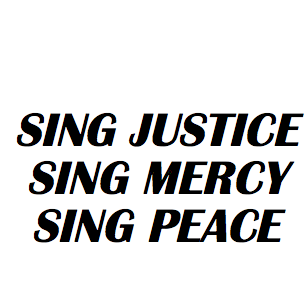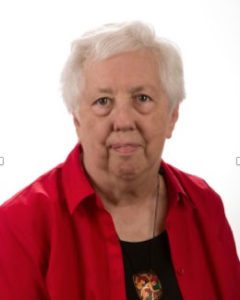
Sing Justice, Sing Mercy, Sing Peace
The Hebrew prophets had a lot to say about justice. Amos admonished the people to “let justice roll down like waters, and righteous like an ever-flowing stream.” Micah talked of the Lord requiring us to do justice. The writers of the Psalms also spoke of justice. God is described as a lover of righteousness and justice in Psalm 33:5. Mary sang of God’s justice in the Magnificat and Jesus often told of God’s justice through his parables and actions.
One of the tools used to motivate the involvement of people in a variety of social causes was, and still is, music and song. In the past strong songs were written calling slavery a sin and such were sung in abolition meetings, in churches, and in schools challenging people to join the abolition movement. There were songs about the temperance movement, child labor, voting rights, etc.
Today hymns of justice can be found in all parts of the world. They have been used to set the tone for political change, to promote peace and freedom, and to address the evils within society. They have been written based on the scriptural understanding that God’s reign is about love, peace, and justice for all God’s children.
Congregations have sung songs of justice for years. Sometimes the singing has been easy, sometimes it has been hard. The intensity of the singing depends on whether justice is understood to be a requirement of discipleship and a part of God’s mission in God’s world. At times the singing of justice is hypocrisy and the words from Amos is once again needed. “Take away from me the noise of your songs; I will not listen to the melody of your harps.” (Amos 5:23) Singing becomes nothing more than noise when acts of justice, kindness, and mercy are not implemented by the congregation and the individuals who are doing the singing.
The music of the Civil Rights movement in the United States involved group participation and was an energizing part of the movement. Some of the songs used in the movements were new, but many were adapted from the spirituals and old gospel songs. Songs were sung at rallies, demonstrations, on the way to and in jail, at sit-ins, and on freedom rides. Singing helped people overcome their fear and became a tool of survival. Singing was nonviolent action in the midst of extreme violence. Some of these songs are being sung today on the streets, during protests, as racism continues to spread it’s hate, fear and violence across our land. The transformed spiritual “Over My Head I See Freedom in the Air” has simple words but extremely powerful message of the desire for freedom and victory from oppression. It can be sung as a prayer or a call to protest in a comforting or militant manner. “Over my head, I see freedom in the air…There must be a God somewhere.”
Working for justice is at times full of risk, often uncomfortable, and most times requires behavioral, political or theological changes for the participant. Our singing of justice though must move us along the journey that is long, full of roadblocks, obstacles, and there is no certainty of victory. Brian Wren, in his hymn “Spirit of Jesus” reminds us of both the uncertainty and the hope for a new world. Below is stanza 2 and 3 of his hymn.
And if, when I have answered need with kindness,
my neighbor rises, wakened from despair,
keep me from flinching when the cry for justice
requires of me the changes that I fear.
If I am hugging safety or possessions,
uncurl my spirit, as your love prevails,
to join my neighbors, work for liberation,
and find my freedom at the mark of nails.
His hymn forces us to face the realities of the world. Justice requires of all of us changes that perhaps we would rather not make. The choice is ours; are we willing to be workers for and singers of justice?
Joyce D. Sohl, Laywoman-in-Residence
 Joyce D. Sohl has been Laywoman-in-Residence since 2009 as a full-time volunteer. She retired as CEO of United Methodist Women in 2004. She is the author of 4 books, a teacher, retreat leader, writer and non-professional musician. Here at the Center her work is in the area of Spirituality & the Arts with such programs as Tuesdays in the Chapel, Vespers & All That Jazz, Poet’s Corner, quarterly retreats, and art exhibits.
Joyce D. Sohl has been Laywoman-in-Residence since 2009 as a full-time volunteer. She retired as CEO of United Methodist Women in 2004. She is the author of 4 books, a teacher, retreat leader, writer and non-professional musician. Here at the Center her work is in the area of Spirituality & the Arts with such programs as Tuesdays in the Chapel, Vespers & All That Jazz, Poet’s Corner, quarterly retreats, and art exhibits.
